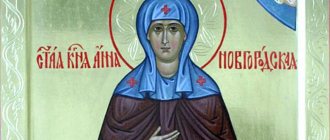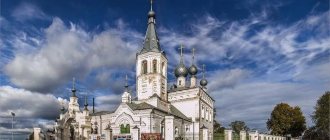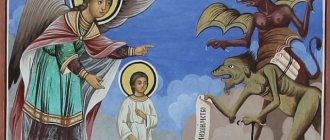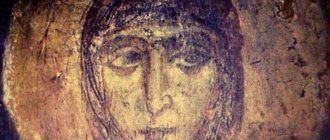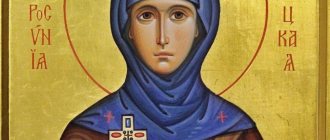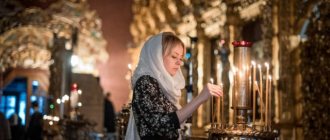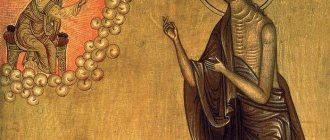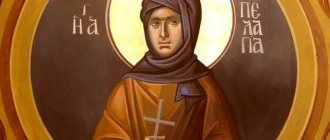ELENA
(Manturova Elena Vasilievna; ca. 1805, village of Nucha Ardatovsky district, Nizhny Novgorod province - 05.28. 1832), rev. Diveyevo (memorial May 28, July 21 - in the Cathedral of the Reverend Wives of Diveyevo). The main source of information about E. is the biography compiled from the memoirs of her brother M.V. Manturov († July 7, 1858), novices and cell attendants K.V. monasticism of Agnia, † 1863), E. M. Puchinskaya († after 1881), A. G. Garina († February 18, 1891), N. A. Motovilov, confessor Archpriest. Vasily Sadovsky († June 14, 1884) and other contemporaries. E.'s biography was kept in the archive in the list of manuscripts of Serafimov Diveevsky in the name of the Holy Trinity convent in notebook No. 11. By 2008, the location of the manuscript is unknown. The main surviving source is the “Chronicle of the Seraphim-Diveevsky Monastery”, compiled by Metropolitan. sschmch. Seraphim (Chichagov) based on the archive of the Diveyevo Monastery. The censorship file on the “Chronicle Legend of the Seraphim-Diveevsky Monastery” (RGIA. F. 796. Op. 170. D. 2484, 1889), submitted in 1889 to the Moscow Spiritual Censorship Committee, has also been preserved. 1st chapter section “D” is dedicated to E. The “Chronicle Legend...” was not allowed by censorship for publication and was used in the compilation of the “Chronicle...” by Metropolitan. Seraphim. By 2008, a number of archival documents had been identified that made it possible to clarify and supplement the biography of E.
7 scenes from the Life of St. Elena Diveevskaya. Icon. 20s XX century (Serafimov Diveevo Trinity Monastery) 7 scenes from the Life of St. Elena Diveevskaya. Icon. 20s XX century (Serafimov Diveevo Trinity Monastery)
Genus. in the family of titular adviser V.F. Manturov. She was orphaned early and lived with her older brother Mikhail. According to the Chronicle of the Seraphim-Diveevo Monastery, ca. 1822 Manturova experienced a strong spiritual shock. Returning from her grandfather's funeral, she was frightened by the vision of a huge black snake trying to devour her. Only the invocation of the Mother of God and the promise to go to the monastery made the monster disappear. From that time on, Manturova began to seek advice and guidance from St. Seraphim of Sarov, who prepared her for monastic life and in 1825 blessed her to enter a small (30 people) wives. community at the parish Kazan church. With. Diveev, founded by St. Alexandra Diveevskaya (Melgunova)
At first E. lived in a closet next to the common sister’s cell, then in a small cell built by her brother, which she shared with her ex. servant Ustinia Andreeva, who was released, and after her death with novices Ksenia Vasilyevna Putkova and Agafia Petrovna Volokova. With the blessing of St. Seraphima E. performed a special daily prayer rule (akathist, Psalter, selected psalms and the rule from Matins), before lunch she constantly read the Jesus Prayer, and after that - “Most Holy Theotokos, save us!” Along with the evening rule, I read the Jesus Prayer and the Holy Prayer 100 times. Mother of God. The elder commanded E. to remain silent, answering briefly only when necessary. E. was engaged in spinning flax and learned to weave. She ate baked potatoes and flat cakes, ate once a day on Wednesday and Friday, and slept on a stone bed covered with a rug. Being educated, E. repeatedly carried out various assignments for St. Seraphim, concerning the acquisition of land for the construction of a cathedral and the consecration of churches, wrote letters to benefactors. Together with the sisters of the community, she dug a ditch for the Queen of Heaven.
In 1826, Rev. Seraphim intended to make E. the head of the Kazan community instead of the ill Ksenia Mikhailovna Kocheulova. In 1827, Rev. Seraphim established the Mill girls' monastery in Diveyevo, and transferred 7 sisters from the previous community to it. He appointed E. as the boss, but she humbly refused. St. Seraphim ordered the sisters to take E.’s blessing in everything and treat her as a boss. At the same time, E. lived in her cell in the Kazan community until her death.
In 1827-1830 With the funds from the sale of her estate with her brother, the Churches of the Nativity of Christ and the Nativity of the Most Holy One were built. Mother of God at the Kazan Church for the sisters of 2 Diveyevo communities. Since the consecration of the temples, Aug. 6. 1829 and 21 Sep. 1830, E. was appointed Rev. Seraphim sacristan and assigned to sexton obedience. Between 1829 and 1830 E. was tonsured by the Sarov priest. Hilarion in the Rasophore. Under her kamilavka, she had a hat made from the St. Peter's bridles. Seraphim himself wore it during his tonsure. E. read the indefatigable Psalter, because there were few literate sisters in the monastery. According to the chronicle of the monastery, demons repeatedly intimidated the ascetic, appearing in different images, therefore St. Seraphim forbade E. to remain alone in the church at any time.
In 1829-1830 E. bought from the Zhdanovs the land on which the buildings and vegetable gardens of the Kazan community were located. E. helped both communities in case of lack of funds and was engaged in secret charity to the poor.
According to the recollections of the novices, E. foresaw the imminent death of St. Seraphim, who repeatedly announced the cut to the sisters. In the biography of the ascetic collected by Metropolitan. Seraphim (Chichagov), it is reported that she died on May 28, 1832 “by obedience” to St. Seraphim instead of his brother, who was mortally ill, but still had to work hard for the Mill community. During the days of her dying illness, E. repeatedly received unction and received communion. It is also recorded in the chronicle that before her death E. was granted a certain vision: she was taken to worship the Tsar and Queen, who promised to take her to themselves. Then the Supreme Abbess, the Queen of Heaven, showed her the heavenly future of the Diveyevo sisters. In the last hours before her death, the saint discovered the gift of clairvoyance. According to some information, before the death of St. Seraphim tonsured E. into the schema. On May 29, E. was buried in an oak coffin sent by St. Seraphim, and in his shirt on the right side of the Kazan Church, near the grave of St. Alexandra (Melgunova). According to eyewitnesses, during the funeral service E. smiled three times in her coffin. For forty days, with the blessing of the elder, funeral liturgies were served.
In the “Chronicle of the Seraphim-Diveevo Monastery” the words of St. Seraphim, said about E. that “she was honored to sit not far from the Holy Trinity, like a virgin,” that she is “a maid of honor of the Queen of Heaven” and “over time, her power and Mary Semyonovna [St. Martha of Diveyevo] will rest openly in the monastery.” He also called E. etc. Martha "the firstfruits of the sisters of the Mill community in heaven."
After the death of the saint, the Yelets image of the Mother of God from 1773 in a silver and gilded robe, E.’s parental blessing, and the icon of the Dormition of the Most Holy Mother remained in the monastery. The Virgin Mary in foil, an icon of the Savior carrying the cross, made by E. with beads on wax. By 2008, the location of the shrines was unknown.
The veneration of E. began in Diveevo shortly after her death. From the end 50s XIX century The monastery recorded miracles and healings that took place at E.’s grave (the records have not been preserved). After the closure of the Diveyevo Monastery in 1927 and the subsequent closure of the Kazan parish church in 1937. the graves near the temple were demolished. In July 1991, excavations were carried out, revealing the burial places of St. Alexandra, St. Marfa, E. and Motovilov. The grave mounds were restored and crosses were erected. In con. Sep. 2000 in connection with the preparation of the glorification of St. Alexandra, St. Marfa and E. excavations were carried out, during which on September 27. the relics of the ascetics were found. 22 Dec In 2000, E., together with other ascetics, was canonized as locally revered saints of the Nizhny Novgorod diocese. The Council of Bishops of the Russian Orthodox Church in 2004 glorified it for church-wide veneration. The relics are in the c. Nativity of the Most Holy Mother of God Seraphim of the Diveyevo Monastery.
Arch.: RGIA. F. 796. Op. 170. D. 2484, 1889; Central Asia of the Nizhny Novgorod region. F. 5. Op. 45. D. 116. L. 35, 37; F. 152. Op. 96. D. 208, 593, 758; F. 570. Op. 556. D. 201. L. 8-8 vol., 17, 19, 1828; Central Asia of the Nizhny Novgorod region - 3 (Balahna). F. 570. Op. 559 "A". D. 310, 950, 966, 982, 999, 1014, 1029, 1060; Op. 559 "B". D. 409. No. 19; D. 981. No. 9.
Lit.: Seraphim (Chichagov), archimandrite. Chronicle of the Seraphim-Diveevsky Monastery. St. Petersburg, 19032, 1996. P. XIII, 156, 164-171, 186, 191-192, 216-217, 259, 271-274, 276-277, 287-288, 293-294, 417-425, 732; Life of St. Elena Diveevskaya. [Diveevo,] 2000; Lives of Saints Alexandra, Martha and Elena of Diveevsky. [Diveevo,] 2001; Finding St. relics of the venerable wives of Diveevo Alexandra the First, Martha and Elena // Diveevo Central Committee, 2001. Diveevo, 2000. P. 98-101, 123-126, 170; Lebedinsky L., prot. East. description of Diveyevo women. communities 1839 // Nizhny Novgorod antiquity. 2004. Issue. 8. P. 35-40; Belyaev S.A. Finding Diveyevo shrines // St. Seraphim of Sarov: Hagiography, veneration, iconography. M., 2004. S. 211-222; Notes of N. A. Motovilov. M., 2005. P. 152; Definition of Holy Bishops' Council of the Russian Orthodox Church October 3-8. 2004 // PCC, 2006. M., 2005. P. 10.
Priest Georgy Pavlovich
Iconography
E. took shape in the Seraphim Diveyevo Monastery. A supposed portrait of the saint of the 2nd quarter has been preserved there. XIX century (?) on canvas, close in pictorial execution to the works of artists of the Arzamas school of A.V. Stupin, probably a copy of the lifetime one. E. is presented against a dark background, chest-length, half-turned to the right, in dark clothes and a headscarf, with a characteristic round face and wide-set eyes (St. Seraphim of Sarov. 2004. pp. 284-285).
St. Elena Diveevskaya. Portrait. 2nd quarter XIX century (?) (Serafimov Diveevo Trinity Monastery) St. Elena Diveevskaya. Portrait. 2nd quarter XIX century (?) (Serafimov Diveevo Trinity Monastery)
By the 20s. XX century refers to an attempt to develop a hagiographic iconography of the saint: a multi-subject pictorial image of the saint was created, close in the location of the marks to the hagiographic icon (kept in the possession of schema Margarita (Lakhtionova), currently in the archives of the Seraphim Diveyevo Monastery). In the middle of this small work, painted in oil on plywood, there is the composition “The Queen of Heaven shows El[ena] V[asilievna] the heavenly Diveev.” The stamps contain scenes: E. sees the “fiery serpent”, St. Seraphim blesses E. to enter the Diveyevo monastery, a ghost frightens E. while reading the Psalter in the church, E. digs the Mother of God ditch, St. Seraphim blesses E. to die in place of his brother, vision of the Most Holy. The Virgin Mary, angels and saints E. before death. The venerable one is depicted primarily in a black monastic robe, without a halo (like St. Seraphim), her name is abbreviated or indicated by initials (“E.V.”). A similar work with a slightly different composition of marks is mentioned by Archpriest. Stefan Lyashevsky as about the work of his wife K. Z. Lyashevskaya (Maria in monasticism) (Seraphim-Diveyevo legends / Comp.: A. N. Strizhev. M., 2001. P. 466-467; Zelenina Ya. E. “To everyone in sweetness came the vision of your face...": St. Seraphim of Sarov - from portrait to icon // Our Heritage. M., 2004. No. 70. P. 15). There is an opinion that the image was made by an artist. N. N. Kazintseva, author of the hagiographic icon of St. Alexandra (Melgunova), Diveevskaya (location unknown, see: Diveevsky PCC, 2001 / Publishing house of the Seraphim-Diveevsky Monastery. [Diveevo,] 2000. P. 167; compare a similar image: Lives of the Reverends. 2001. P. 29).
The first icon of E. was written by mon. Irina (Kuimova) for the local canonization of St. wives of the Diveevskys in 2000 (Life of St. Elena Diveevskaya. 2000. Incl.). This is a half-length, rectilinear image on a golden background: E. in a green robe and dark monastic clothes, his right hand is slightly raised to his chest, and in his left hand is a scroll. The image was created on the basis of a picturesque portrait of E. in the tradition. iconographic style; by 2008 it was located near the E. crayfish in the c. Nativity of the Most Holy Mother of God. The image of St. 3 took part in the rite of glorification. the wives of Diveyevo (E. on the right), who are depicted full-length under the icon of the Mother of God “The Sign” (2000, see: Lives of the Venerables. 2001. Incl.).
In the Seraphim Diveyevo Monastery, in its hermitages and farmsteads, several people are revered. icons of E., as a rule, together with the Venerable Alexandra and Martha, with particles of their relics, painted in the Diveyevo icon-painting workshop based on the editions of the first icons (see, for example: Holy Trinity Seraphim-Diveyevo Convent: 15 years of revival ( 1991-2006). [Diveevo,] 2006. P. 60). In the iconostasis of the chapel of St. Nicholas the Wonderworker monastery church. In honor of the Kazan Icon of the Mother of God, the image of 3 St. women (2004), in the local row of the iconostasis of the Trinity Cathedral - the icon “Cathedral of the Diveyevo Saints”, made in the monastery in 2006.
The image of E. is found in monumental painting: in the painting of the Kazan Church. monastery included the composition “St. Seraphim blesses St. Elena (Manturova) to die by obedience” (2003-2004, artist D. V. Shabalina). E. is written in one of the medallions in the painting of the Transfiguration Cathedral of the monastery (2004, a team of Samara icon painters under the direction of A. A. Belyaev). In the mural of the refectory c. led book blgv. Alexander Nevsky E. is presented in the Cathedral of Diveyevo Saints (2002-2003, work of Palekh masters). In a watercolor drawing from 2000 by nun Nadezhda (Krasovitskaya) (private collection), the saint is depicted full-length, with a rosary in her left hand, against a landscape background with a mill (Life of St. Elena Diveevskaya. 2000. P. 5).
Lit.: Life of St. Elena Diveevskaya. [Diveevo,] 2000; Lives of Saints Alexandra, Martha and Elena of Diveevsky. [Diveevo,] 2001; St. Seraphim of Sarov: Hagiography. Reverence. Iconography / Comp., rep. ed.: N. N. Chugreeva. M., 2004. pp. 318-319.
E.P.I.
Life
Reverend Elena Diveevskaya Elena Vasilievna Manturova came from an old noble family, her father was a titular councilor. Having been orphaned early, Elena lived with her brother Mikhail in the family village of Nucha, Nizhny Novgorod province. At the age of 17, a girl who aspired to a secular life was miraculously turned to spiritual life. Returning from her grandfather's funeral, she saw a terrible snake that was about to devour her. The girl prayed: Queen of Heaven, save me! I swear to you to never get married and go to a monastery, after which the snake immediately disappeared. After this incident, wanting to fulfill her promise, Elena Vasilievna changed: she began to read spiritual books and pray a lot. Soon Elena Vasilievna went to Sarov to see Father Seraphim to ask for his blessing to enter the monastery. But only three years later, the Monk Seraphim of Sarov blessed Elena to enter the Diveyevo Kazan community. Unusually kind by nature, the Monk Elena helped the sisters a lot. From the time of the consecration of the temples attached to the Kazan Church (the Nativity of Christ and the Nativity of the Virgin Mary), Father Seraphim appointed her as a churchwoman and sacristan. For this purpose, she was tonsured into the ryassophore. The saint died at the age of 27 in 1832, having received many miraculous visions before her death. Seeing this, the holy Elder sent everyone to Diveevo: Quickly, quickly come to the monastery, there our great lady has gone to the Lord! On the fortieth day after her death, Father Seraphim predicted that over time her relics would rest openly in the monastery. Miracles and healings occurred more than once at the grave of St. Helena. On September 26, 2000, the incorruptible relics of the Venerable Elena Diveevskaya were discovered, which, according to the prophecy of Father Seraphim, were solemnly placed in the Church of the Nativity of the Virgin. Through the prayers of the Venerable Elena Diveevskaya, miracles of healing from diseases of the legs, joints, toothache and headaches, mental disorders and other diseases were performed.
Church of St. equal to Prince Vladimir Moscow
REVEREND ELENA DIVEEVSKAYA (MANTUROVA)
Remembrance Day June 10 (according to modern times)
In our church there is an icon of the Cathedral of the Diveyevo Holy Women, in which particles of their relics are built, including St. Helena of Diveyevo.
Reverend Elena Diveevskaya, in the world Elena Vasilievna Manturova, came from an old noble family and lived with her brother Mikhail Vasilyevich in the ancestral village of Nucha, Nizhny Novgorod province. At the age of 17, a girl who aspired to a secular life was miraculously turned to spiritual life. She dreamed of a terrible snake that was about to devour her. The girl prayed: “Queen of Heaven, save me! I give you an oath - never to get married and go to a monastery!” The snake immediately disappeared. After this incident, Elena Vasilievna changed, began to read spiritual books, and pray a lot. She was eager to fulfill her promise. Soon Elena Vasilievna went to Sarov to see Father Seraphim to ask for his blessing to enter the monastery. But only three years later, the Monk Seraphim of Sarov blessed Elena to enter the Diveyevo Kazan community.
Unusually kind by nature, the Monk Elena helped the sisters a lot. According to the commandment given to her by her spiritual father, she remained silent and constantly prayed. From the time of the consecration of the temples attached to the Kazan Church (the Nativity of Christ and the Nativity of the Virgin Mary), Father Seraphim appointed Elena Vasilievna as a churchwoman and sacristan. For this purpose, she was tonsured into the ryassophore.
So she lived in the monastery until she was 27 years old. Before her death, Elena Vasilievna was honored with many wonderful visions. After several days of illness, on May 28, 1832, on the eve of the Holy Trinity, she died quietly. Seeing this in spirit, the holy elder sent everyone to Diveevo: “Hurry, quickly come to the monastery, there our great lady has gone to the Lord!” On the fortieth day after her death, Father Seraphim predicted that “over time, her relics will rest openly in the monastery.” Miracles and healings happened more than once at Elena Vasilievna’s grave. Until its closure in 1927, the monastery kept church books in which these cases were described in detail, but they have not reached us. On September 26, 2000, the incorruptible relics of the Venerable Elena Diveevskaya were discovered, which, together with the relics of Schema-nun Alexandra (Melgunova) and Schema-nun Martha (Melyukova), according to the prophecy of Father Seraphim, were solemnly placed in the Church of the Nativity of the Virgin. On December 22, 2000, she was glorified as a locally revered saint of the Nizhny Novgorod diocese. Orthodox believers remember the newly-minted saint of the Russian Land on May 28 (June 10) and July 8 (21), the day of the celebration of the Council of the Holy Wives of Diveyevo.
Through the prayers of the Venerable Elena Diveevskaya, miracles of healing from diseases of the legs, joints, toothache and headaches, mental disorders and other diseases were performed.
The text is compiled based on materials from azbyka ru

